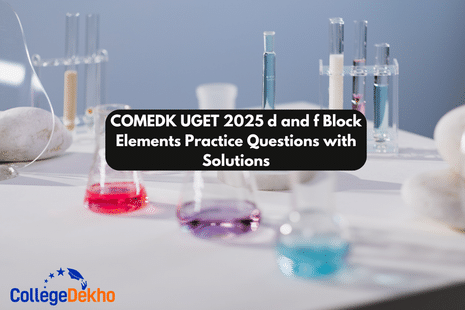
COMEDK UGET 2025 'd and f' Block Elements Practice Questions with Solutions: The chapter on 'd and f' Block Elements covers a good number of questions in the COMEDK entrance exam. COMEDK UGET 2025 d and Block Elements practice questions with solutions will include topics such as Ionic radii, Colour, Catalytic property, Magnetic properties etc. With an average weightage of 8%, the chapter on 'd and f' Block Elements is expected to cover around 1-5 questions in the COMEDK UGET 2025 exam . The COMEDK UGET syllabus will hold topics from 11th & 12th standards, therefore, you are advised to practice from the COMEDK 'd and f' Block Elements sample questions on a regular basis. By doing this, you will become familiar with the exam pattern, types of questions, their weightage, and more. Practicing these questions will also help you recognize the frequently repeated ones in the exams. In this article, we will explore the COMEDK UGET 2025 'd and f' Block Elements practice questions with solutions. By solving these, you can enhance your chances of success in the examination.
Also Check -
COMEDK Chapter Wise PYQs for Chemistry
Quick Links:
COMEDK UGET 2025 'd and f' Block Elements Important Topics
The chapter on 'd and f' Block Elements in COMEDK UGET 2025 Chemistry syllabus covers several subtopics, including the occurrence and characteristics of transition metals, general trends in the properties of first-row transition metals—such as metallic character, ionization enthalpy, and oxidation states, among others. It is important to note that the COMEDK UGET exam will feature important questions based on these topics. Therefore, you must focus on these areas. Below is the list of COMEDK UGET 2025 'd and f' Block Elements subtopics for exam preparation.
Chapter | Topics |
|---|---|
'd and f' Block Elements |
|
Also Check - Do or Die Chapters for COMEDK UGET 2025 Chemistry
COMEDK UGET 2025 'd and f' Block Elements Expected Weightage
As an aspirant examinee, you must be aware of the weightage and the total number of questions that the 'd and f' Block Elements topic will carry. Understanding this will help you prepare effectively. The table below provides a summary of the expected weightage of the COMEDK UGET 'd and f' Block Elements, along with the expected number of topics.
Topic | Expected Number of Questions | Expected Weightage |
|---|---|---|
'd and f' Block Elements | 1-5 | 1-8% |
Quick Links:
COMEDK UGET 2025 'd and f' Block Elements Practice Questions with Solutions
Regularly practicing COMEDK UGET 'd and f' Block Elements sample questions can greatly improve your exam preparation. By solving COMEDK 'd and f' Block Elements practice questions with solutions, you can get acquainted with potential exam questions, confirm correct answers, and grasp step-by-step solutions. Below are some key COMEDK UGET 2025 'd and f' Block Elements practice questions, carefully curated by experts from past exam papers.
Q1. Identify the correct statement from the following:
a) The green manganate ion shows diamagnetic nature but the permanganate ion exhibits paramagnetic nature.
b) Interstitial compounds of transition metals have lower melting points than that of pure transition metals and their compounds are chemically reactive
c) Cerium is a lanthanoid metal which exists in a stable oxidation state of +4, besides exhibiting an oxidation state of +3
d) Cr (VI) is more stable than W (VI) and hence acts as a good oxidising agent
Correct answer:
c) Cerium is a lanthanoid metal which exists in a stable oxidation state of +4, besides exhibiting an oxidation state of +3
Solution:
Each of the given statements needs to be examined carefully to identify the correct one. Let's analyze them one by one:
Option A: The green manganate ion shows diamagnetic nature, but the permanganate ion exhibits paramagnetic nature.
This statement is not correct because both the manganate ion (MnO 2- 4 ) and the permanganate ion (MnO - 4 ) are paramagnetic in nature, as both contain unpaired electrons in their d-orbitals.
Option B: Interstitial compounds of transition metals have lower melting points than that of pure transition metals and their compounds are chemically reactive.
This statement is also not correct. Interstitial compounds typically have higher melting points compared to their pure metals due to the presence of small atoms (like hydrogen, carbon, or nitrogen) in the interstices of the metal lattice structure, which enhances the metallic bonding. Additionally, they are generally less reactive than their constituent metals.
Option C: Cerium is a lanthanoid metal which exists in a stable oxidation state of +4, besides exhibiting an oxidation state of +3.
This statement is correct. Cerium (Ce) indeed has two common oxidation states: +3 and +4. The +3 oxidation state is more common for lanthanoids, but cerium is unique in that it can exist stably in the +4 oxidation state as well.
Option D: Cr (VI) is more stable than W (VI) and hence acts as a good oxidising agent.
This statement is not correct. In fact, W(VI) is generally more stable than Cr(VI), Chromium (VI) compounds are strong oxidizing agents, indicating they are less stable and readily reduced.
Therefore, the correct statement is:
Option C: Cerium is a lanthanoid metal which exists in a stable oxidation state of +4, besides exhibiting an oxidation state of +3.
Q2. The correct order of increasing melting point is:
a) CR < Ti < V < Mn
b) Mn < TI < V < Cr
c) Ti < V < Cr < Mn
d) V < Ti < Mn < Cr
Correct answer:
b) Mn < TI < V < Cr
Solution:
We can compare the approximate melting points in (in ℃) of the given elements:
Manganese (Mn) ~ 1246℃
Titanium (Ti) ~ 1668℃
Chromium (Cr) ~ 1907℃
Vanadium (V) ~ 1910℃
Thus, when we order them from lowest to highest, we have:
Mn (1246℃) < Ti (1668℃) < Cr (1907℃) < V (1910℃)
However, note that the melting points of chromium and vanadium are extremely close (differing by only about 3℃); in many texts and competitive exam questions the order is given using one of these two as the highest. Among the provided options, only Option B begins with manganese as the lowest and titanium following it. Option B gives:
Mn < TI < V < Cr
This is the answer most commonly accepted in such questions, even though some sources might slightly swap the last two due to the close values.
Thus, the answer is Option B.
Q3. In 3d-transmission series, which one has the least melting point?
a) V
b) Zn
c) Mn
d) Cu
Correct answer:
b) Zn
Solution:
The melting point of d-block elements is due to the presence of unpaired electrons in the last d-orbital or s-orbital. So, the element which has all the electrons in pairs will have the least melting point.
[Ar] 3d 3 4s 2 has 3 unpaired electrons.
Zinc (Zn) with atomic number 30.[Ar] 3d 10 4s 2 has zero unpaired electron.
Manganese (Mn) with atomic number 25.[Ar] 3d 5 4s 2 has five unpaired electrons.
Copper (Cu) with atomic number 29.
[Ar] 3d
10
4s
1
has one unpaired electron.
Therefore, zinc has least melting point.
Q4. Formation of coloured solution is possible, when metal ion in the compound contains
a) paired electrons
b) unpaired electrons
c) Ione pair of electrons
d) None of the above
Correct answer:
b) unpaired electrons
Solution:
Formation of coloured solution is possible, when metal ion in the compound contains unpaired electrons due to transition of electrons in excited state.
Q5. Which of the following forms a colourless solution in aqueous medium?
a) Ti 3+
b) Sc 3+
c) V 3+
d) Cr 3+
Correct answer:
b) Sc
3+
Solution:
The electronic configuration of Sc is
1s 2 2s 2 2p 6 3s 2 3p 6 3d 1 4s 2
Electronic configuration of Sc 3+ is 1s 2 2s 2 2p 6 3s 2 3p 6
So, Sc 3+ is colourless due to the absence of unpaired electrons in d-orbital.
Related Articles
Are you feeling lost and unsure about what career path to take after completing 12th standard?
Say goodbye to confusion and hello to a bright future!

Was this article helpful?




















Similar Articles
What is a Good Score in KLUEEE 2026
KL University vs VIT Vellore: Which has better placement for CSE?
List of JEE Main Exam Centres in Bihar 2026
Best IIT JEE Coaching Institutes in Chennai With Fee Structure
Unable to Download JEE Main 2026 Admit Card? Find Out the Reasons & Solutions Here
JEE Main 2026 Helpline Number - Centre, Phone Number, Address